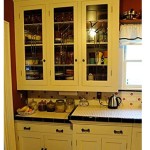How To Clean Metal Handles On Kitchen Cabinets
Kitchen cabinets, subjected to frequent use and proximity to cooking areas, often accumulate grime and grease, particularly on the metal handles. Routine cleaning is essential not only for aesthetic purposes but also for maintaining hygiene and preventing the buildup of stubborn residues that can be difficult to remove over time. This article provides a comprehensive guide on effectively cleaning metal handles on kitchen cabinets, detailing various methods and techniques suitable for different types of metals and levels of soiling.
Identifying the Metal Type
Before initiating any cleaning process, it is crucial to identify the type of metal the handles are made of. Different metals require different cleaning approaches to avoid damage, discoloration, or corrosion. Common metals used for kitchen cabinet handles include stainless steel, brass, bronze, nickel, and aluminum. Each metal possesses unique properties and reacts differently to various cleaning agents.
Stainless steel is generally durable and resistant to rust, making it relatively easy to clean. Brass, on the other hand, is prone to tarnishing and requires specific cleaning agents designed for brass. Bronze, similar to brass, can also tarnish and may develop a patina over time, which some individuals prefer to retain. Nickel-plated handles are susceptible to scratching and should be cleaned with gentle, non-abrasive methods. Aluminum is lightweight and corrosion-resistant, but it can be easily stained by acidic cleaners. Identifying the metal type allows for selection of the appropriate cleaning solutions and techniques, minimizing the risk of damage and ensuring optimal results.
If unsure about the metal type, a discreet test can be performed. A small, inconspicuous area of the handle can be tested with a metal cleaner intended for a specific metal. Observe the reaction carefully. If discoloration or damage occurs, discontinue use and select a different cleaning method. Alternatively, consulting the cabinet manufacturer's documentation or contacting the manufacturer directly can provide definitive information about the metal composition of the handles.
Gathering Necessary Supplies
Once the metal type has been identified, the necessary cleaning supplies can be assembled. The supplies required will vary depending on the chosen cleaning method, but some common items include:
*Microfiber cloths: These are essential for wiping surfaces clean and polishing metal without scratching. Several cloths should be available to ensure a clean cloth is always used.
*Soft-bristled brush: A toothbrush or similar soft-bristled brush is useful for scrubbing crevices and hard-to-reach areas.
*Cleaning solutions: The specific cleaning solution will depend on the metal type and the severity of the grime. Options include mild dish soap, white vinegar, baking soda, commercial metal cleaners, and specially formulated stainless steel cleaners.
*Warm water: Warm water is used to dilute cleaning solutions and rinse surfaces.
*Spray bottle: A spray bottle is useful for applying cleaning solutions evenly.
*Protective gloves: Wearing gloves protects the hands from harsh chemicals and prevents the transfer of oils and dirt from the hands to the handles.
*Polishing cloth: A polishing cloth, often made of flannel or a similar soft material, is used to buff the metal handles after cleaning to restore their shine.
Having all the necessary supplies readily available streamlines the cleaning process and ensures that the chosen method can be implemented effectively. It is also important to read the instructions and warnings on any commercial cleaning products before use.
Step-by-Step Cleaning Methods
Several methods can be used to clean metal handles on kitchen cabinets, each with its own advantages and disadvantages. The choice of method will depend on the metal type, the level of soiling, and personal preference.
Method 1: Mild Dish Soap and Water
This is the gentlest and safest method for cleaning most metal handles. It is particularly suitable for light cleaning and maintenance.
1. Fill a bowl with warm water and add a few drops of mild dish soap. Mix well to create a soapy solution.
2. Dip a microfiber cloth into the soapy solution and wring out excess water.
3. Wipe the metal handles thoroughly, paying attention to areas with grime and fingerprints.
4. Use a soft-bristled brush to scrub any stubborn dirt or grease in crevices.
5. Rinse the handles with clean water, using a separate microfiber cloth.
6. Dry the handles completely with a clean, dry microfiber cloth. This prevents water spots and potential corrosion.
This method is effective for removing everyday dirt and grime without damaging the metal surface. It is a suitable option for regular maintenance and can be used on most metal types.
Method 2: White Vinegar and Water
White vinegar is a natural cleaning agent that can effectively remove grease and grime. It is particularly useful for cleaning stainless steel and brass, but it should be used with caution on other metals.
1. Mix equal parts white vinegar and warm water in a spray bottle.
2. Spray the solution onto the metal handles, ensuring they are evenly coated.
3. Allow the solution to sit for a few minutes to loosen the grime.
4. Wipe the handles with a microfiber cloth, scrubbing gently if necessary.
5. Rinse the handles thoroughly with clean water.
6. Dry the handles completely with a clean, dry microfiber cloth.
For brass handles, a slightly different approach can be used. Mix a paste of white vinegar and salt. Apply the paste to the brass handles and let it sit for about 15-30 minutes. Rinse thoroughly with water and dry completely.
When using vinegar, it is essential to test a small, inconspicuous area first to ensure it does not damage or discolor the metal. Avoid using vinegar on aluminum handles, as it can cause staining.
Method 3: Baking Soda Paste
Baking soda is a mild abrasive that can be used to remove stubborn stains and grime. It is suitable for cleaning stainless steel and other durable metals, but it should be used with caution on softer metals like nickel.
1. Mix baking soda with a small amount of water to create a thick paste.
2. Apply the paste to the metal handles, focusing on areas with stubborn stains.
3. Gently scrub the handles with a soft-bristled brush or a microfiber cloth.
4. Rinse the handles thoroughly with clean water.
5. Dry the handles completely with a clean, dry microfiber cloth.
Baking soda is effective for removing grease, grime, and water spots. However, it is important to avoid using excessive pressure when scrubbing, as this can scratch the metal surface. A test in an inconspicuous area is advised before applying to the entire handle.
Method 4: Commercial Metal Cleaners
Commercial metal cleaners are specifically formulated to clean and polish various types of metals. These cleaners often contain ingredients that remove tarnish, rust, and other types of stains. It is crucial to select a cleaner that is designed for the specific type of metal being cleaned.
1. Read the instructions on the commercial metal cleaner carefully.
2. Apply the cleaner to a microfiber cloth, following the product instructions.
3. Wipe the metal handles with the cloth, applying gentle pressure.
4. Buff the handles with a clean, dry microfiber cloth to restore their shine.
When using commercial metal cleaners, it is important to wear protective gloves and work in a well-ventilated area. Some cleaners may contain harsh chemicals that can irritate the skin and respiratory system. Always follow the manufacturer's instructions and safety precautions. Before using a commercial cleaner on all handles, test the product a small portion of a single handle to ensure that the product doesn't remove or damage the existing finish.
Preventive Measures and Maintenance
Regular cleaning and preventive measures can significantly reduce the buildup of grime and grease on metal handles, making future cleaning tasks easier. Wiping down the handles with a damp cloth after each use can prevent dirt and spills from setting.
Applying a protective coating, such as a metal polish or wax, can also help to repel dirt and water, making the handles easier to clean and maintain their shine. The frequency of cleaning will depend on the level of use and the environment. Kitchens that are used frequently may require more frequent cleaning than those that are used less often.
Avoiding the use of harsh chemicals and abrasive cleaners can also prolong the life of the metal handles and prevent damage. Gentle cleaning methods, such as mild soap and water, are often sufficient for routine maintenance.
Maintaining a clean kitchen environment overall can also help to prevent the buildup of grime on metal handles. Regularly cleaning countertops, backsplashes, and other surfaces can reduce the amount of airborne grease and dirt that accumulates on the handles.

We Used Our Favorite On These Kitchen Cabinets And The Results Were Amazing Farmers Almanac Plan Your Day Grow Life

How To Clean Old Furniture Hardware Remove Paint From

How To Clean Kitchen Cabinets Of All Types

How To Clean Chrome Kitchen Cabinet Handles Decor And

Diy Metal Cleaning Solutions For Your Home Door Hardware Metals Hiatt

How To Clean Chrome Kitchen Cabinet Handles Decor And

How To Clean Kitchen Cabinet Hardware Pro Tips For Wooden Cabinets

How To Clean Metal Handles On Kitchen Cabinets Countyoffice Org

How To Clean Kitchen Cabinets Of All Types

How To Clean Greasy Kitchen Cabinet Hardware
Related Posts








